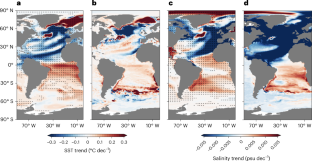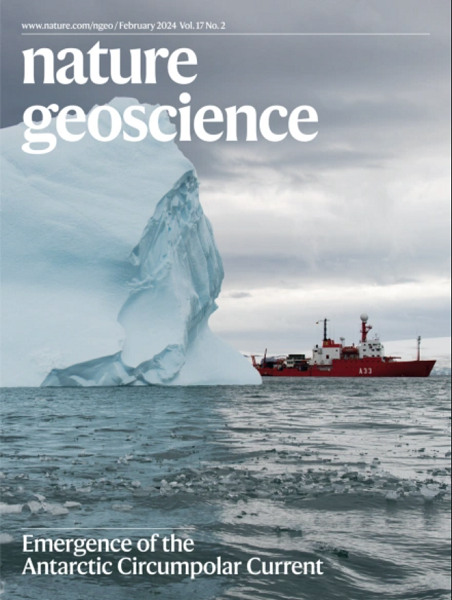二十世纪中叶以来亚北极清新驱动的大西洋经向翻转环流减弱现象
IF 15.7
1区 地球科学
Q1 GEOSCIENCES, MULTIDISCIPLINARY
引用次数: 0
摘要
大西洋经向翻转环流是当今大西洋热量向北输送的主要驱动力,决定着全球气候模式。在过去的一个世纪中,全球变暖是否影响了这一翻转环流的强度仍存在争议:观测研究表明,自二十世纪中叶以来,这一环流持续减弱,而气候模式则系统地模拟了稳定的环流。在这里,我们利用地球系统和允许涡流的海洋-海冰耦合模式表明,亚北极大西洋的清新和翻转环流的减弱通过开尔文波和罗斯比波的传播,在十年时间尺度上增加了南大西洋的温度和盐度。我们还表明,在历史模拟中考虑上端融水输入可显著改善大西洋经向翻转环流过去变化的数据-模型一致性,自 1950 年以来每十年减慢 0.46 sverdrups。根据对未来一个世纪亚北极融水输入的估计,在全球变暖 2 ℃ 的情况下,这一环流可能会比其人为未扰动状态减弱 33%。这种翻转环流的减弱将对气候和生态系统产生重大影响。本文章由计算机程序翻译,如有差异,请以英文原文为准。


Weakening of the Atlantic Meridional Overturning Circulation driven by subarctic freshening since the mid-twentieth century
The Atlantic Meridional Overturning Circulation is the main driver of northward heat transport in the Atlantic Ocean today, setting global climate patterns. Whether global warming has affected the strength of this overturning circulation over the past century is still debated: observational studies suggest that there has been persistent weakening since the mid-twentieth century, whereas climate models systematically simulate a stable circulation. Here, using Earth system and eddy-permitting coupled ocean–sea-ice models, we show that a freshening of the subarctic Atlantic Ocean and weakening of the overturning circulation increase the temperature and salinity of the South Atlantic on a decadal timescale through the propagation of Kelvin and Rossby waves. We also show that accounting for upper-end meltwater input in historical simulations significantly improves the data–model agreement on past changes in the Atlantic Meridional Overturning Circulation, yielding a slowdown of 0.46 sverdrups per decade since 1950. Including estimates of subarctic meltwater input for the coming century suggests that this circulation could be 33% weaker than its anthropogenically unperturbed state under 2 °C of global warming, which could be reached over the coming decade. Such a weakening of the overturning circulation would substantially affect the climate and ecosystems. Fresh meltwater entering the Labrador and Irminger seas has resulted in a slowing of the Atlantic Meridional Overturning Circulation since the 1950s, according to a combination of modelling approaches.
求助全文
通过发布文献求助,成功后即可免费获取论文全文。
去求助
来源期刊

Nature Geoscience
地学-地球科学综合
CiteScore
26.70
自引率
1.60%
发文量
187
审稿时长
3.3 months
期刊介绍:
Nature Geoscience is a monthly interdisciplinary journal that gathers top-tier research spanning Earth Sciences and related fields.
The journal covers all geoscience disciplines, including fieldwork, modeling, and theoretical studies.
Topics include atmospheric science, biogeochemistry, climate science, geobiology, geochemistry, geoinformatics, remote sensing, geology, geomagnetism, paleomagnetism, geomorphology, geophysics, glaciology, hydrology, limnology, mineralogy, oceanography, paleontology, paleoclimatology, paleoceanography, petrology, planetary science, seismology, space physics, tectonics, and volcanology.
Nature Geoscience upholds its commitment to publishing significant, high-quality Earth Sciences research through fair, rapid, and rigorous peer review, overseen by a team of full-time professional editors.
 求助内容:
求助内容: 应助结果提醒方式:
应助结果提醒方式:


